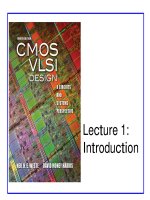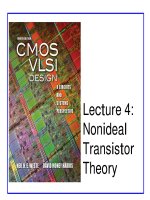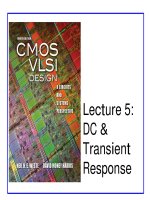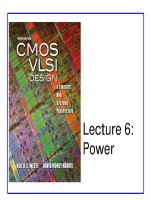CMOS VLSI DESIGN pps
Bạn đang xem bản rút gọn của tài liệu. Xem và tải ngay bản đầy đủ của tài liệu tại đây (1.23 MB, 50 trang )
© December 31, 2007 Dr. Lynn Fuller
Rochester Institute of Technology
Microelectronic Engineering
CMOS VLSI DESIGN
Page 1
ROCHESTER INSTITUTE OF TECHNOLOGY
MICROELECTRONIC ENGINEERING
CMOS VLSI DESIGN
Dr. Lynn Fuller
Webpage: /> Microelectronic Engineering
Rochester Institute of Technology
82 Lomb Memorial Drive
Rochester, NY 14623-5604
Tel (585) 475-2035
Fax (585) 475-5041
Email:
Department webpage:
12-31-2007 cmosvlsi2007.ppt
© December 31, 2007 Dr. Lynn Fuller
Rochester Institute of Technology
Microelectronic Engineering
CMOS VLSI DESIGN
Page 2
OUTLINE
Design Approach
Process Technology
MOSIS Design Rules
Primitive Cells, Basic Cells, Macro Cells
Projects
Maskmaking
References
Homework
© December 31, 2007 Dr. Lynn Fuller
Rochester Institute of Technology
Microelectronic Engineering
CMOS VLSI DESIGN
Page 3
THE NEED FOR CAD
With millions of
transistors per chip it is
impossible to
design with no errors
without computers to
check layout, circuit
performance, process
design, etc.
© December 31, 2007 Dr. Lynn Fuller
Rochester Institute of Technology
Microelectronic Engineering
CMOS VLSI DESIGN
Page 4
COMPARISON OF DESIGN METHODOLOGIES
Full Custom Design
Direct control of layout and device parameters
Longer design time
but faster operation
more dense
Standard Cell Design
Easier to implement
Limited cell library selections
Gate Array or
Programmable Logic Array Design
Fastest design turn around
Reduced Performance
© December 31, 2007 Dr. Lynn Fuller
Rochester Institute of Technology
Microelectronic Engineering
CMOS VLSI DESIGN
Page 5
STAGES IN THE CAD PROCESS
Problem Specification
Behavioral Design
Functional and Logic Design
Circuit Design
Physical Design (Layout)
Fabrication Technology CAD (TCAD)
Packaging
Testing
© December 31, 2007 Dr. Lynn Fuller
Rochester Institute of Technology
Microelectronic Engineering
CMOS VLSI DESIGN
Page 6
DESIGN HEIRARCHY - LEVELS OF ABSTRACTION
A = B + C
if (A) then X: = Y
Block-Functional Model
Gate-Level Model
Transistor level Model
Geometric Model
ALU
Behavioral Model
RAM
© December 31, 2007 Dr. Lynn Fuller
Rochester Institute of Technology
Microelectronic Engineering
CMOS VLSI DESIGN
Page 7
PROCESS SELECTION
It is not necessary to know all process details to do CMOS
integrated circuit design. However the process determines
important circuit parameters such as supply voltage and maximum
frequency of operation. It also determines if devices other than
PMOS and NMOS transistors can be realized such as poly-to-poly
capacitors and EEPROM transistors. The number of metal
interconnect layers is also part of the process definition.
© December 31, 2007 Dr. Lynn Fuller
Rochester Institute of Technology
Microelectronic Engineering
CMOS VLSI DESIGN
Page 8
RIT SUBµ CMOS
RIT Subµ CMOS
150 mm wafers
Nsub = 1E15 cm-3
Nn-well = 3E16 cm-3
Xj = 2.5 µm
Np-well = 1E16 cm-3
Xj = 3.0 µm
LOCOS
Field Ox = 6000 Å
Xox = 150 Å
Lmin= 1.0 µm
LDD/Side Wall Spacers
Vdd = 5 Volts, Vto= +/- 1 Volt
Two Layer Metal
L
Long
Channel
Behavior
© December 31, 2007 Dr. Lynn Fuller
Rochester Institute of Technology
Microelectronic Engineering
CMOS VLSI DESIGN
Page 9
RIT SUBµ CMOS
0.75 µm Aluminum
N-type Substrate 10 ohm-cm
P-well
N-well
6000 Å
Field Oxide
NMOSFET
PMOSFET
N+ Poly
Channel Stop
P+ D/S
N+ D/S
LDD
LDD
n+ well
contact
p+ well
contact
© December 31, 2007 Dr. Lynn Fuller
Rochester Institute of Technology
Microelectronic Engineering
CMOS VLSI DESIGN
Page 10
RIT ADVANCED CMOS VER 150
RIT Advanced CMOS
150 mm Wafers
Nsub = 1E15 cm-3 or 10 ohm-cm, p
Nn-well = 1E17 cm-3
Xj = 2.5 µm
Np-well = 1E17 cm-3
Xj = 2.5 µm
Shallow Trench Isolation
Field Ox (Trench Fill) = 4000 Å
Dual Doped Gate n+ and p+
Xox = 100 Å
Lmin = 0.5 µm , Lpoly = 0.35 µm, Leff = 0.11 µm
LDD/Nitride Side Wall Spacers
TiSi2 Salicide
Tungsten Plugs, CMP, 2 Layers Aluminum
L
Long
Channel
Behavior
Vdd = 3.3 volts
Vto=+- 0.75 volts
© December 31, 2007 Dr. Lynn Fuller
Rochester Institute of Technology
Microelectronic Engineering
CMOS VLSI DESIGN
Page 11
RIT ADVANCED CMOS
NMOSFET
PMOSFET
N-wellP-well
N+ Poly
P+ D/S
N+ D/S
LDD
LDD
n+ well
contact
p+ well
contact
P+ Poly
© December 31, 2007 Dr. Lynn Fuller
Rochester Institute of Technology
Microelectronic Engineering
CMOS VLSI DESIGN
Page 12
LAMBDA, Lmin, Ldrawn, Lmask, Lpoly, Lint, Leff, L
Leff
L
Source at 0 V
Drain at 3.3V
Gate
Ldrawn
Lmask
Lpoly
Lmin = min drawn poly length, 2λ
Lresist after photo (resist trimming??)
Lmask = ? Depends on +/-bias
Lpoly after poly reoxidation
Internal Channel Length, Lint =distance between junctions, including under diffusion
Effective Channel Length, Leff = distance between space charge layers,Vd = Vs= 0
Channel Length, L, = distance between space charge layers, when Vd= what it is
Extracted Channel Length Parameters = anything that makes the fit good (not real)
Lint
0.50µm
1.00µm x 5
0.50µm
0.35µm
0.30µm
0.20µm
0.11µm
Lpoly after poly etch
0.40µm
Ldrawn = what was drawn
Lambda = design rule parameter, λ, ie 0.25µm
© December 31, 2007 Dr. Lynn Fuller
Rochester Institute of Technology
Microelectronic Engineering
CMOS VLSI DESIGN
Page 13
MOSIS TSMC 0.35 2POLY 4 METAL PROCESS
/>© December 31, 2007 Dr. Lynn Fuller
Rochester Institute of Technology
Microelectronic Engineering
CMOS VLSI DESIGN
Page 14
MOSIS TSMC 0.35 2-POLY 4-METAL LAYERS
Metal2.i
Via.i
Metal1.i
Contact.i
P_plus_select.i
N_plus_select.i
Poly.i
Active.i
N_well.i
MENTOR
NAME
51METAL2
50VIA
49METAL1
Active_contact.i 48
poly_contact.i 47
25CONTACT
44P PLUS
45N PLUS
46POLY
43ACTIVE
42N WELL
COMMENTGDS
#
MASK
LAYER NAME
© December 31, 2007 Dr. Lynn Fuller
Rochester Institute of Technology
Microelectronic Engineering
CMOS VLSI DESIGN
Page 15
MORE LAYERS USED IN MASK MAKING
Placed on nwell level mask82nw_res
Placed on first level mask81alignment
n plus
p plus
LDD
pmos_vt
channel_stop
active_lettering
cell_outline.i
NAME
Overlay/Resolution for N+ Mask88
Overlay/Resolution for P+ Mask87
Overlay/Resolution for LDD Masks86
Overlay/Resolution for Vt Mask85
Overlay/Resolution for Stop Mask84
Placed on active mask83
Not used70
COMMENTGDS LAYER
© December 31, 2007 Dr. Lynn Fuller
Rochester Institute of Technology
Microelectronic Engineering
CMOS VLSI DESIGN
Page 16
OTHER LAYERS
N-WELL (42)
ACTIVE (43)
POLY (46)
P-SELECT (44)
N-SELECT (45)
CC (25)
METAL 1 (49)
VIA (50)
METAL 2 (51)
Design Layers
Other Design Layers
P+ Resolution (87)
STI Resolution (82)
Stop Resolution (84)
Vt Resolution (85)
Active Resolution (83)
N+ Resolution (88)
2.0
1.5
1.0
2.0
1.5
1.0
2.0
1.5
1.0
2.0
1.5
1.0
Active
Stop
STI
83
Nmos Vt
Poly
2.0
1.5
1.0
P+
2.0
1.5
1.0
N+
88
85
46
81
84
87
42
45
49
43
44
25
© December 31, 2007 Dr. Lynn Fuller
Rochester Institute of Technology
Microelectronic Engineering
CMOS VLSI DESIGN
Page 17
LAMBDA BASED DESIGN RULES
The design rules may change from foundry to foundry or for
different technologies. So to make the design rules generic the
sizes, separations and overlap are given in terms of numbers of
lambda (λ). The actual size is found by multiplying the number by
the value for lambda.
For example:
RIT PMOS process λ = 10 µm and minimum metal width
is 3 λ so that gives a minimum metal width of 30 µm. The RIT
CMOS process (single well) has λ = 4 µm and the minimum metal
width is also 3 λ so minimum metal is 12 µm but if we send our
CMOS designs out to industry λ might be 0.8 µm so the minimum
metal of 3 λ corresponds to 2.4 µm. In all cases the design rule is
the minimum metal width = 3 λ
© December 31, 2007 Dr. Lynn Fuller
Rochester Institute of Technology
Microelectronic Engineering
CMOS VLSI DESIGN
Page 18
LAYOUT RULES
Perfect Overlay
Slight Overlay
Not Fatal
Misalignment
Fatal
Layout rules prevent slight misalignment from being fatal.
© December 31, 2007 Dr. Lynn Fuller
Rochester Institute of Technology
Microelectronic Engineering
CMOS VLSI DESIGN
Page 19
MOSIS LAMBDA BASED DESIGN RULES
10
6
9
Well
Same
Potential
Diff
Potential
3
3
3
Active in p-well
n+
p+
n+
well edge
n-Substrate
(Outside well)
5
Poly
2
2
3
2
1
Poly
Poly
Active
1
p select
active
2
3
contact to poly
2
2
2
2
metal
2
1
2
3
3
1
1
If λ = 1 µm then contact is
2 µm x 2 µm
p+
5
n+
3
/>© December 31, 2007 Dr. Lynn Fuller
Rochester Institute of Technology
Microelectronic Engineering
CMOS VLSI DESIGN
Page 20
MOSIS LAMBDA BASED DESIGN RULES
metal two
2
1
2
4
3
1
1
/>MOSIS Educational Program
Instructional Processes Include:
AMI λ = 0.8 µm SCMOS Rules
AMI λ = 0.35 µm SCMOS Rules
Research Processes:
go down to poly length of 65nm
© December 31, 2007 Dr. Lynn Fuller
Rochester Institute of Technology
Microelectronic Engineering
CMOS VLSI DESIGN
Page 21
MOSIS REQUIREMENTS
MOSIS requires that projects have successfully passed LVS (Layout
Versus Schematic) and DRC (Design Rule Checking). Our
MENTOR tools for LVS and DRC (as they are set up) require
separate N-select and P-select levels in order to know an NMOS
transistor from a PMOS transistor. Although either an N-well, P-
well or both will work for a twin well process, we have set up our
DRC to look for N-well.
© December 31, 2007 Dr. Lynn Fuller
Rochester Institute of Technology
Microelectronic Engineering
CMOS VLSI DESIGN
Page 22
RIT PROCESSES
At RIT we use the SMFL-CMOS or Sub-CMOS processes for most
designs. In these processes the minimum poly length is 2µm and
1µm respectively. We use scalable MOSIS design rules with lambda
equal to 1µm and 0.5µm. These processes use one layer of poly and
two layers of metal.
The examples on the following pages are designs that could be made
with either of the above processes. As a result the designs are
generous, meaning that larger than minimum dimensions are used.
For example λ = 1µm and minimum poly is 2λ but biased to 2.5µm
because our poly etch is isotropic. (alternatively this biasing could be
done at mask making)
The design approach for digital circuits is to design primitive cells
and then use the primitive cells to design basic cells which are then
used in the project designs. A layout approach is also used that
allows for easy assembly of these cells into more complex cells.
© December 31, 2007 Dr. Lynn Fuller
Rochester Institute of Technology
Microelectronic Engineering
CMOS VLSI DESIGN
Page 23
PRIMITIVE CELLS
Inverter
NOR2
NOR3
NOR4
NAND2
NAND3
NAND4
Etc.
Primitive Cells
© December 31, 2007 Dr. Lynn Fuller
Rochester Institute of Technology
Microelectronic Engineering
CMOS VLSI DESIGN
Page 24
CMOS INVERTER
Vin Vout
Vin
CMOS
+V
Vout
Idd
TRUTH TABLE
VOUTVIN
0 1
1 0
PMOS
NMOS
W = 40 µm
Ldrawn = 2.5µm
Lpoly = 1.0µm
Leff = 0.35 µm
© December 31, 2007 Dr. Lynn Fuller
Rochester Institute of Technology
Microelectronic Engineering
CMOS VLSI DESIGN
Page 25
NOR and NAND
VOUT
VB
0 0 1
0 1 0
1 0 0
1 1 0
VA
VA
VOUT
VB
+V
VOUT
VA
VB
VOUT
VB
0 0 1
0 1 1
1 0 1
1 1 0
VA
VA
VOUT
VB
+V
VOUT
VA
VB









